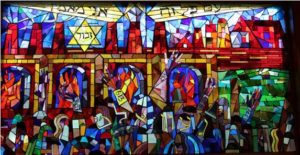The Holocaust
David Holleman (Arlington, MA 1927–2020 Lexington, MA)
USA, 1960’s
Stained glass with epoxy edge gluing mounted on plate glass, h. 12 ft. x w. 5ft.
Cincinnati Skirball Museum, gift of Congregation Beth Shalom of the Blue Hills, formerly Temple Beth El, Quincy, MA and Temple Shalom, Milton, MA, 2015.1.5
This window was given by the people of Temple Beth El in sacred memory of their six million Jewish brethren, innocent victims of the unspeakable Nazi brutality. Their tragic fate is a grim reminder of the havoc wrought by blind hatred and a stern warning to all people against silence in the face of tyranny.
The Holocaust window depicts six smokestacks for the six million Jews who were killed. The smoke coming out of them becomes the wings that represent the Shechinah, God’s hovering presence, with the words: Im Kol Zeh- Ani Ma-amin– “Even with all this, I still believe.”
The barbed wire and the brick walls depict the strict confinement of the people but there is a glimpse of life outside the camp. In front of the ovens belching flames are the backs of people with different hats, describing their beliefs and origins. Hands are closed, making a fist, and then are open, admitting the light of God, even at this terrible moment. The central arm has the number 613, representing the Torah’s 613 mitzvot, or commandments. Across the bottom is the Yiddish phrase, Gevalt, written in Hebrew Letters, which literally means shriek, scream, violence. The phrase is part of the indistinct jumble/ chaos which is pushed towards the fire.
The artist used no distinct human representation, but the infamous yellow Mogen David or Star of David, which Jews were forced to wear throughout Nazi-occupied Europe, bears the word Zekhor– “Remember,” instead of the word Jew.

